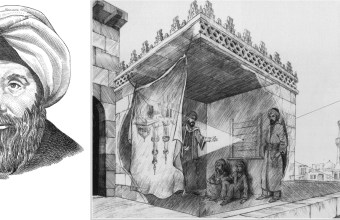Physics

July 4, 2017
Physics
Published: 2002
The Holy Quran had awakened a spirit of inquiry among the Arabs, which was instrumental in their splendid achievements in the field of science and, according to a western critic, led them to realize that “science could not be advanced by mere speculation; its only sure progress lay in the practical interrogation of nature. The essential characteristics of their method are experiment and observation.
The Muslims developed physics to a high degree and produced eminent physicists like Kindi, al-Beruni, and Ar-Razi. Abu Yusuf Ibn Ishaq, known as al-Kindi, was born at Kufa in the middle of the 9th century and flourished in Baghdad. He is the most dominating and one of the greatest Muslim scholars of physics. He applied mathematics not only to physics but also to medicine.
Camera Obscura, 1400
Therefore, he was regarded by Cardon, a philosopher of the Renaissance, “as one of the 12 subtlest minds.” He thought that gold and silver could only be obtained from mines and not through any other process. He endeavored to ascertain the laws that govern the fall of bodies.
Al Razi
Razi investigated the determination of specific gravity of means of hydrostatic balance, called by him Mizan-al-Tabii. Most of his works on physics, mathematics, astronomy, and optics have perished. In physics, his writings deal with matter, space, time, and motion.
In his opinion, matter in the primitive state before creating the world was composed of scattered atoms, which possessed an extent. Mixed in various proportions with the empty articles, these atoms produced these elements, which are five in number, namely, earth, air, water, fire, and celestial element.
Abu Rehan Beruni was a versatile genius who adorned the durbar of Mahmud of Ghazni. His outstanding achievement in the realm of physics was the accurate determination of the weight of 18 stones. He also discovered that light travels faster than sound. He has also contributed immensely to geological knowledge by providing the correct explanation of natural spring and artesian wells’ formation.
He suggested that the Indus Valley was formerly an ancient basin filled with alluvial soil. His Kitab al Jawahir deals with different types of gems and their specific gravity. A voluminous unedited lapidary by Betuni is kept in manuscript form in the Escorial Library. It deals with many stones and metals from natural, commercial and medical points of view.
What is Taught: In the 17th century, the pendulum was developed by Galileo during his teenage years. He noticed a chandelier swaying as the wind was blowing it. As a result, he went home and invented the pendulum.
Pendulum
What Should be Taught: Ibn Yunus al-Masri discovered the pendulum during the 10th century, who was the first to study and document its oscillatory motion. Muslim physicists introduced its value for use in clocks during the 15th century.
What is Taught: Galileo (17th century) was the world’s first great experimenter.
What Should be Taught: Al-Biruni (d. 1050) was the world’s first great experimenter. He wrote over 200 books, many of which discuss his precise experiments.
His literary output in the sciences amounts to some 13,000 pages, far exceeding that written by Galileo or, for that matter, Galileo and Newton combined.
Using math in Physics and Astronomy, Ibn Al-Haytham wrote treatises on the light of the moon, in which he argues that the moon shines like a self-luminous object, though its light is borrowed from the sun. He wrote on the Halo and Rainbow, on Spherical Burning Mirrors, on Paraboloidal Burning Mirrors, and on the shape of an eclipse, which examines the camera.
Recommended Posts

Women’s Rights to Own Property
January 20, 2018

Navigation
January 20, 2018

Algebra
July 4, 2017

